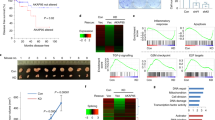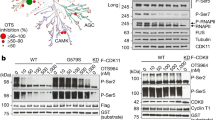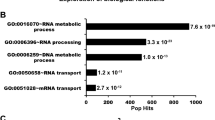Abstract
Checkpoint kinase 2 (CHK2) kinase is a key mediator in many cellular responses to genotoxic stresses, including ionizing radiation (IR) and topoisomerase inhibitors. Upon IR, CHK2 is activated by ataxia telangiectasia mutated kinase and regulates the S-phase and G1-S checkpoints, apoptosis and DNA repair by phosphorylating downstream target proteins, such as p53 and Brca1. In addition, CHK2 is thought to be a multi-organ cancer susceptibility gene. In this study, we used a tandem affinity purification strategy to identify proteins that interact with CHK2 kinase. Cyclin-dependent kinase 11 (CDK11)p110 kinase, implicated in pre-mRNA splicing and transcription, was identified as a CHK2-interacting protein. CHK2 kinase phosphorylated CDK11p110 on serine 737 in vitro. Unexpectedly, CHK2 kinase constitutively phosphorylated CDK11p110 in a DNA damage-independent manner. At a molecular level, CDK11p110 phosphorylation was required for homodimerization without affecting its kinase activity. Overexpression of CHK2 promoted pre-mRNA splicing. Conversely, CHK2 depletion decreased endogenous splicing activity. Mutation of the phosphorylation site in CDK11p110 to alanine abrogated its splicing-activating activity. These results provide the first evidence that CHK2 kinase promotes pre-mRNA splicing via phosphorylating CDK11p110.
This is a preview of subscription content, access via your institution
Access options
Subscribe to this journal
Receive 50 print issues and online access
$259.00 per year
only $5.18 per issue
Buy this article
- Purchase on Springer Link
- Instant access to full article PDF
Prices may be subject to local taxes which are calculated during checkout






Similar content being viewed by others
References
Matsuoka S, Huang M, Elledge SJ . Linkage of ATM to cell cycle regulation by the Chk2 protein kinase. Science 1998; 282: 1893–1897.
Ahn J, Prives C . Checkpoint kinase 2 (Chk2) monomers or dimers phosphorylate Cdc25C after DNA damage regardless of threonine 68 phosphorylation. J Biol Chem 2002; 277: 48418–48426.
Chaturvedi P, Eng WK, Zhu Y, Mattern MR, Mishra R, Hurle MR et al. Mammalian Chk2 is a downstream effector of the ATM-dependent DNA damage checkpoint pathway. Oncogene 1999; 18: 4047–4054.
Darbon JM, Penary M, Escalas N, Casagrande F, Goubin-Gramatica F, Baudouin C et al. Distinct Chk2 activation pathways are triggered by genistein and DNA-damaging agents in human melanoma cells. J Biol Chem 2000; 275: 15363–15369.
Pommier Y, Weinstein JN, Aladjem MI, Kohn KW . Chk2 molecular interaction map and rationale for Chk2 inhibitors. Clin Cancer Res 2006; 12: 2657–2661.
Bartek J, Falck J, Lukas J . CHK2 kinase--a busy messenger. Nat Rev Mol Cell Biol 2001; 2: 877–886.
Solier S, Sordet O, Kohn KW, Pommier Y . Death receptor-induced activation of the Chk2- and histone H2AX-associated DNA damage response pathways. Mol Cell Biol 2009; 29: 68–82.
Hirao A, Kong YY, Matsuoka S, Wakeham A, Ruland J, Yoshida H et al. DNA damage-induced activation of p53 by the checkpoint kinase Chk2. Science 2000; 287: 1824–1827.
Shieh SY, Ahn J, Tamai K, Taya Y, Prives C . The human homologs of checkpoint kinases Chk1 and Cds1 (Chk2) phosphorylate p53 at multiple DNA damage-inducible sites. Genes Dev 2000; 14: 289–300.
Chehab NH, Malikzay A, Appel M, Halazonetis TD . Chk2/hCds1 functions as a DNA damage checkpoint in G(1) by stabilizing p53. Genes Dev 2000; 14: 278–288.
Falck J, Mailand N, Syljuasen RG, Bartek J, Lukas J . The ATM-Chk2-Cdc25A checkpoint pathway guards against radioresistant DNA synthesis. Nature 2001; 410: 842–847.
Lee JS, Collins KM, Brown AL, Lee CH, Chung JH . hCds1-mediated phosphorylation of BRCA1 regulates the DNA damage response. Nature 2000; 404: 201–204.
Yang S, Kuo C, Bisi JE, Kim MK . PML-dependent apoptosis after DNA damage is regulated by the checkpoint kinase hCds1/Chk2. Nat Cell Biol 2002; 4: 865–870.
Pabla N, Huang S, Mi QS, Daniel R, Dong Z . ATR-Chk2 signaling in p53 activation and DNA damage response during cisplatin-induced apoptosis. J Biol Chem 2008; 283: 6572–6583.
Lee SB, Kim SH, Bell DW, Wahrer DC, Schiripo TA, Jorczak MM et al. Destabilization of CHK2 by a missense mutation associated with Li-Fraumeni Syndrome. Cancer Res 2001; 61: 8062–8067.
Stolz A, Ertych N, Kienitz A, Vogel C, Schneider V, Fritz B et al. The CHK2-BRCA1 tumour suppressor pathway ensures chromosomal stability in human somatic cells. Nat Cell Biol 2010; 12: 492–499.
Loyer P, Trembley JH, Grenet JA, Busson A, Corlu A, Zhao W et al. Characterization of cyclin L1 and L2 interactions with CDK11 and splicing factors: influence of cyclin L isoforms on splice site selection. J Biol Chem 2008; 283: 7721–7732.
Cornelis S, Bruynooghe Y, Denecker G, Van Huffel S, Tinton S, Beyaert R . Identification and characterization of a novel cell cycle-regulated internal ribosome entry site. Mol Cell 2000; 5: 597–605.
Sachs NA, Vaillancourt RR . Cyclin-dependent kinase 11(p110) activity in the absence of CK2. Biochim Biophys Acta 2003; 1624: 98–108.
Hu D, Mayeda A, Trembley JH, Lahti JM, Kidd VJ . CDK11 complexes promote pre-mRNA splicing. J Biol Chem 2003; 278: 8623–8629.
Trembley JH, Hu D, Hsu LC, Yeung CY, Slaughter C, Lahti JM et al. PITSLRE p110 protein kinases associate with transcription complexes and affect their activity. J Biol Chem 2002; 277: 2589–2596.
Wilker EW, van Vugt MA, Artim SA, Huang PH, Petersen CP, Reinhardt HC et al. 14-3-3sigma controls mitotic translation to facilitate cytokinesis. Nature 2007; 446: 329–332.
Petretti C, Savoian M, Montembault E, Glover DM, Prigent C, Giet R . The PITSLRE/CDK11p58 protein kinase promotes centrosome maturation and bipolar spindle formation. EMBO Rep 2006; 7: 418–424.
Hu D, Valentine M, Kidd VJ, Lahti JM . CDK11(p58) is required for the maintenance of sister chromatid cohesion. J Cell Sci 2007; 120 (Pt 14): 2424–2434.
Franck N, Montembault E, Rome P, Pascal A, Cremet JY, Giet R . CDK11(p58) is required for centriole duplication and Plk4 recruitment to mitotic centrosomes. PLoS One 2011; 6: e14600.
Zong H, Chi Y, Wang Y, Yang Y, Zhang L, Chen H et al. Cyclin D3/CDK11p58 complex is involved in the repression of androgen receptor. Mol Cell Biol 2007; 27: 7125–7142.
Nybakken K, Vokes SA, Lin TY, McMahon AP, Perrimon N . A genome-wide RNA interference screen in Drosophila melanogaster cells for new components of the Hh signaling pathway. Nat Genet 2005; 37: 1323–1332.
Puig O, Caspary F, Rigaut G, Rutz B, Bouveret E, Bragado-Nilsson E et al. The tandem affinity purification (TAP) method: a general procedure of protein complex purification. Methods 2001; 24: 218–229.
Seo GJ, Kim SE, Lee YM, Lee JW, Lee JR, Hahn MJ et al. Determination of substrate specificity and putative substrates of Chk2 kinase. Biochem Biophys Res Commun 2003; 304: 339–343.
O'Neill T, Giarratani L, Chen P, Iyer L, Lee CH, Bobiak M et al. Determination of substrate motifs for human Chk1 and hCds1/Chk2 by the oriented peptide library approach. J Biol Chem 2002; 277: 16102–16115.
Chi Y, Zhang C, Zong H, Hong Y, Kong X, Liu H et al. Thr-370 is responsible for CDK11(p58) autophosphorylation, dimerization, and kinase activity. J Biol Chem 2011; 286: 1748–1757.
Nasim MT, Chowdhury HM, Eperon IC . A double reporter assay for detecting changes in the ratio of spliced and unspliced mRNA in mammalian cells. Nucleic Acids Res 2002; 30: e109.
Younis I, Berg M, Kaida D, Dittmar K, Wang C, Dreyfuss G . Rapid-response splicing reporter screens identify differential regulators of constitutive and alternative splicing. Mol Cell Biol 2010; 30: 1718–1728.
Meijers-Heijboer H, van den Ouweland A, Klijn J, Wasielewski M, de Snoo A, Oldenburg R et al. Low-penetrance susceptibility to breast cancer due to CHEK2(*)1100delC in noncarriers of BRCA1 or BRCA2 mutations. Nat Genet 2002; 31: 55–59.
Dong X, Wang L, Taniguchi K, Wang X, Cunningham JM, McDonnell SK et al. Mutations in CHEK2 associated with prostate cancer risk. Am J Hum Genet 2003; 72: 270–280.
Cybulski C, Gorski B, Huzarski T, Masojc B, Mierzejewski M, Debniak T et al. CHEK2 is a multiorgan cancer susceptibility gene. Am J Hum Genet 2004; 75: 1131–1135.
Valente ST, Gilmartin GM, Venkatarama K, Arriagada G, Goff SP . HIV-1 mRNA 3' end processing is distinctively regulated by eIF3f, CDK11, and splice factor 9G8. Mol Cell 2009; 36: 279–289.
Maniatis T, Reed R . An extensive network of coupling among gene expression machines. Nature 2002; 416: 499–506.
Ward AJ, Cooper TA . The pathobiology of splicing. J Pathol 220: 152–163.
Blencowe BJ . Splicing regulation: the cell cycle connection. Curr Biol 2003; 13: R149–R151.
Lamond AI, Konarska MM, Sharp PA . A mutational analysis of spliceosome assembly: evidence for splice site collaboration during spliceosome formation. Genes Dev 1987; 1: 532–543.
Acknowledgements
We thank Dr Richard R Vaillancourt for providing HA-CDK11p110 expression vector; Dr Anglus I Lamond for pBSAL4 plasmid; Dr Gideon Dreyfuss for pCMV-Luc 2CP/ARE and pCMV-Luc 2CP/Intron/ARE plasmids; Dr Eperon for the pTN24 plasmids; Dr Jin-Hyun Ahn for pDEST-SG5-HA, pDEST-SG5-flag destination vectors and early passage human diploid fibroblast cell lines. This work was supported by NRF Grants 2011-0008174, funded by the Ministry of Science and Technology, Republic of Korea.
Author information
Authors and Affiliations
Corresponding author
Ethics declarations
Competing interests
The authors declare no conflict of interest.
Additional information
Supplementary Information accompanies the paper on the Oncogene website
Supplementary information
Rights and permissions
About this article
Cite this article
Choi, HH., Choi, HK., Jung, S. et al. CHK2 kinase promotes pre-mRNA splicing via phosphorylating CDK11p110. Oncogene 33, 108–115 (2014). https://doi.org/10.1038/onc.2012.535
Received:
Revised:
Accepted:
Published:
Issue Date:
DOI: https://doi.org/10.1038/onc.2012.535
Keywords
This article is cited by
-
Maintenance of genome stability: the unifying role of interconnections between the DNA damage response and RNA-processing pathways
Current Genetics (2018)
-
DNA methylation of the CDC2L1 gene promoter region decreases the expression of the CDK11p58 protein and reduces apoptosis in keloid fibroblasts
Archives of Dermatological Research (2018)
-
Exon-centric regulation of ATM expression is population-dependent and amenable to antisense modification by pseudoexon targeting
Scientific Reports (2016)
-
Preclinical evaluation of cyclin dependent kinase 11 and casein kinase 2 survival kinases as RNA interference targets for triple negative breast cancer therapy
Breast Cancer Research (2015)



